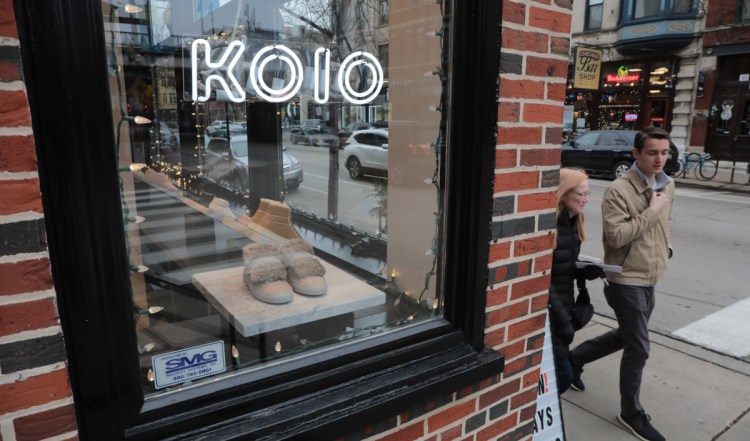Four days before Christmas, athletic apparel retailer Outdoor Voices opened a store in Chicago’s Ranch Triangle neighborhood. It should feel at home among neighbors like Bonobos, Warby Parker and Marine Layer.
All are within a block of one another, and all began as online retailers before opening brick-and-mortar stores. Soon, Outdoor Voices will be sandwiched between two more: home goods brand Parachute to the east, and shoe retailer Allbirds to the west. Parachute opened temporarily for the holidays, but both plan to open their permanent stores this spring.
Brands that start online are increasingly recognizing the importance of brick-and-mortar and amassing the resources to build physical stores. It’s a bright spot in the retail sector, which has seen mass merchants such as Sears, Toys R Us and Carson’s close thousands of stores in recent years.
But don’t count on the newer online brands to fill all that empty space in malls and shopping centers. Most are picky when it comes to where they want to put their stores, and many have their sights set on the same affluent neighborhoods and high-end malls.
Retailers that initially made most, if not all, of their sales online plan to open 850 stores over the next five years, according to a report from real estate firm Jones Lang LaSalle.
Some will undoubtedly end up in Chicago. The city ranked a distant fourth among locations where so-called clicks-to-bricks brands open a first permanent store, behind New York, Los Angeles and San Francisco, Jones Lang LaSalle said. But it’s a natural stop for brands seeking their first destination off the coasts, said Phillip Golding, a vice president at real estate firm CBRE’s urban retail group.
“Chicago is a big market, so there’s an attraction to the trade area and the city as a whole,” he said.
When Italian sneaker-maker Koio decided to expand beyond its first store in New York, it looked to its two next-biggest markets: Los Angeles, where it opened a store in October, and Chicago, co-founder Johannes Quodt said. Koio opened a store near the other online-first brands in the Ranch Triangle neighborhood in November.
Having a physical presence is a way to stand out among the flood of products filling consumers’ Facebook and Instagram feeds.
“If you’re advertising online, you’re next to all these brands,” Quodt said. “If you open a store, you become much more real. People perceive you differently.”
Lingerie brand AdoreMe, which aims to open about 300 stores in the next five years, says it plans to keep its first locations close to its East Coast headquarters and distribution centers. But the company plans to venture farther as it gains experience with physical retail and has already visited Chicago to look at potential locations, said Iris Voltaire, business and brand development manager.
Like many online-first brands, AdoreMe was initially proud to be store-free, Voltaire said. Its subscription model was designed for online retail, and the company was confident it could help customers pick the right fit, she said.

Shopper Marie Goodman loads up on athletic apparel at Outdoor Voices in the 800 block of west Armitage Ave. in Chicago, Friday, Dec. 21, 2018. Some retailers that started as online businesses before opening brick and mortar stores.
But over time, the company dropped the subscription-only model and realized some customers still insist on trying before buying, especially for products like lingerie, where fit is crucial.
Even if most companies now recognize the value of letting customers shop both online and in person, it takes time for brands to get the resources and scale to be ready for brick-and-mortar sales, said Jason Trombley, senior vice president at Jones Lang LaSalle.
“They want to, and it behooves them to do so, but it’s an expensive endeavor,” Trombley said.
There are a few factors working in their favor.
Store closures have made landlords more open to working with newer companies that are reluctant to commit to traditional five- to 10-year leases.
“Vacancies have opened things up for digitally native brands to get a really good deal on a pop-up or short-term lease, and they’re taking advantage of it,” said Gabriella Santaniello, president and founder of the retail research firm A-Line Partners.
There are also companies trying to make the process of opening brick-and-mortar stores easier for brands that lack experience.
Koio was able to open its Chicago store sooner than it otherwise might have because it tapped another company, Leap, to assist with finding a location, negotiating a lease, building out the store and finding staff, Quodt said.
The Chicago Koio store was Leap’s first, and Leap co-CEO Jared Golden declined to say how many other brands the company is working with.
San Francisco-based b8ta also works with companies that want to outsource some or all of the work of operating stores. Companies that don’t yet want to commit to their own locations can pay for space in b8ta’s branded stores, one of which is in The Shops at North Bridge on Chicago’s Michigan Avenue.
“Everyone has the aspiration to own and operate their own stores, but getting the infrastructure to do it isn’t easy,” said Phillip Raub, co-founder and president of b8ta.
Despite growing enthusiasm for brick-and-mortar among e-commerce companies, they will be only part of the solution for filling empty storefronts left by struggling retailers. Many of those stores were part of big-box chains like Toys R Us and Sports Authority, or department stores like Sears and J.C. Penney. They’re far bigger than the average clicks-to-bricks store, which measures about 2,800 square feet, according to Jones Lang LaSalle’s report.
Not only are many of those vacant stores too big, but they’re often in the wrong places.
Clicks-to-bricks brands tend to cluster in the same malls or neighborhoods that are already known as shopping destinations.
Send questions/comments to the editors.



Comments are no longer available on this story